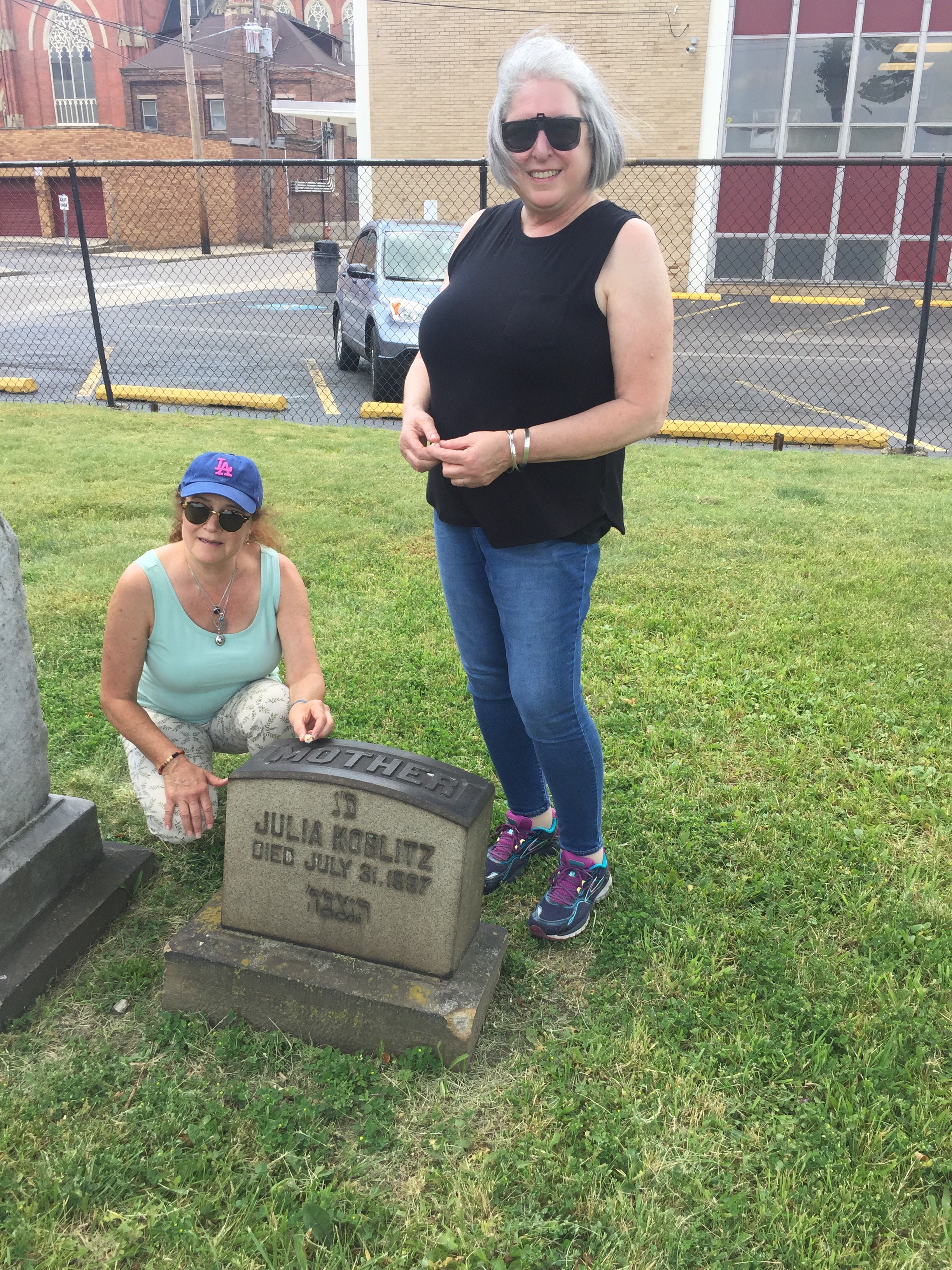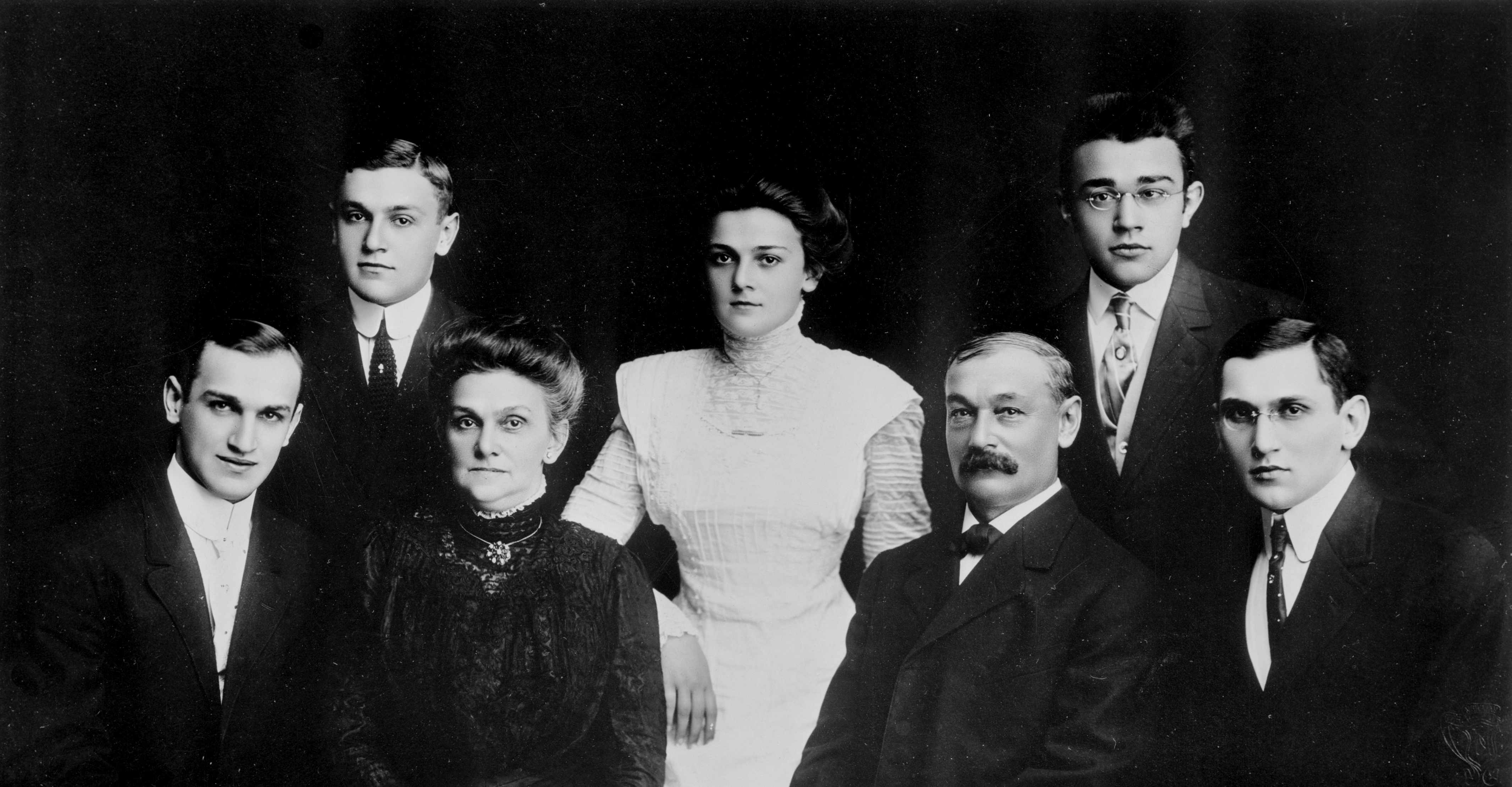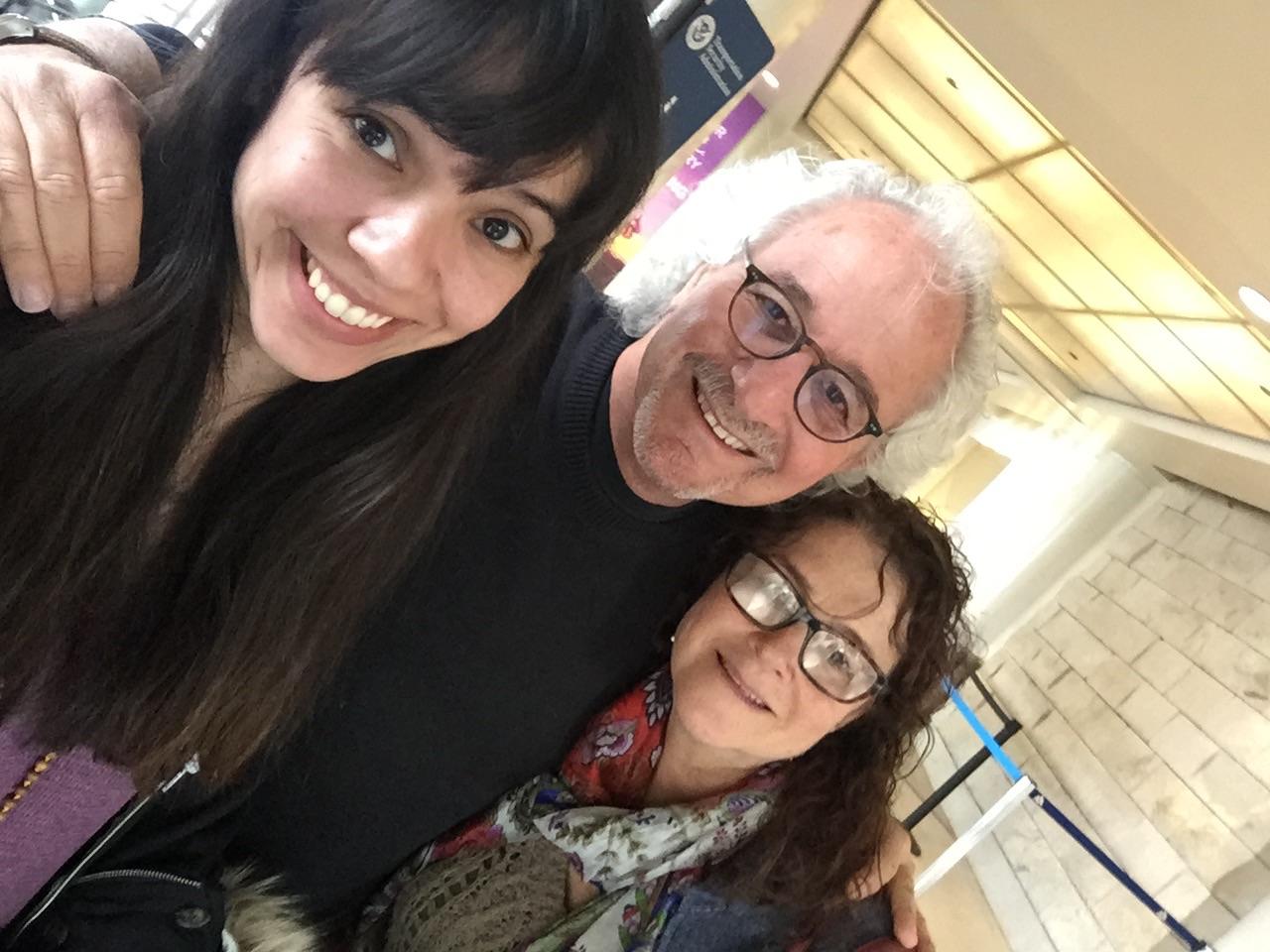American artist and teacher Karen Koblitz talks about her Czech roots

Karen (left) with cousin Beth in front of Julia Koblitz née Meller’s grave at the Baxter Cemetery, Cleveland.
My name is Karen Koblitz and I am a native of Los Angeles, California. I am an artist that works mainly in ceramics and an Associate Professor of Fine Arts, Head of Ceramics in the Roski School of Art & Design at the University of Southern California in Los Angeles. My family heritage is Eastern European; Russian, Bohemian and Austro-Hungarian. I am married, my husband, Alan Friedenberg is a retired Elementary School Principal and we have one daughter, Gina, who is a university student, a senior at the University of Southern California studying Spanish and Psychology.
Your family has roots in Southern Bohemia and links to Pacov. Would you tell us more about them?
I have always been curious as to the history of the Koblitz family. It is my surname and the name of my father, grandfather, going back many generations. My father never talked about the family and I knew that they came from Bohemia. I wanted to know more about the Koblitz family so I began searching their history. In 2010 I was introduced to Julius Müller, director of Toledot, a Jewish family history center in Prague. I asked Julius to help me find a history of the Koblitz family in Bohemia with information that my great great Grandfather was Moses Koblitz who came to the United States in 1873 from Bohemia and settled in Cleveland, Ohio.
In 2014 my husband and I came to Prague and met with Julius and he took us on a tour of the area that my family came from. Julius was able to trace my family back to the late 1700’s when Josef Gershon Koblitz and his wife Katharina Lowi Koblitz lived at number 10 in Bradacov. Josef and Katharina were my great great great Grandparents and had taken the name of Koblitz from that of the landowner, Koblic (the name itself may have been derived from a Germanized version of the Chobolice/Koblice/Keblice place-name – Ed.). This was required of Jews at that time and they were to spell the Bohemian surname in a Germanic way.
Josef and Katharina had many children, including my great great Grandfather Moses, who was born circa 1815. Julius was able to find information on Moses, where he lived, his marriage to Rosalia Růžičková in the Babčice Synagogue in 1853, and the birth of many of their children, the death of Rosalia in 1859 and then the marriage of Moses to Johanna (Julia) Meller in 1860 in the Pacov Synagogue. Julia Meller was from Pacov. Moses lived in many small towns, as he was a peddler of agricultural products from the farms he lived on: hides of cows, wool from sheep and feathers. He lived in Southern Bohemia as documented in records from his birth in Bradáčov, to Pohnání, Mostek, and Rodná. He was part of the Jewish communities in Babčice and Pacov.
Your great great Grandfather later immigrated to the US and you were able to find many interesting related documents…
I have found documentation of Moses and Julia Koblitz coming to America in 1873 on the British ship The Panther that sailed from Hamburg, Germany on July 29, 1873 via Hull to New York. I found the manifest of the ship’s passengers and they include Moses (56 years of age), Johanna “Julia” (56), six of their children from 9 to 28, one daughter-in-law and a grandson that was 6 months of age.
My great Grandfather, Alois “Louis”, was one of those children that immigrated to America. He was 19 years old at the time. I assume that they settled in Cleveland, Ohio as Moses’ brother Markus, also born in Bradáčov, came to America and settled in Cleveland in 1866 and one of Moses and Rosalia’s sons, Joseph, came in 1870. They must have written to Moses to encourage him to come to Cleveland because America didn’t limit Jews in their professions and daily living. The land of opportunity beckoned them.
Can you tell us more about their life in their new homeland?
It is my understanding that my family spoke German, some Hebrew and Czech with their neighbors. I can imagine how difficult it was for them to arrive in a new country not being able to speak the language.

Louis and Hannah Koblitz with their family.
They quickly assimilated into life in Cleveland. At the beginning they bought rags (used clothing and linens) and sold them to companies that made fabric and paper. They then became involved in construction of buildings, real estate and in 1912 Alois “Louis”, his brother Joseph and son, Lawrence (my grandfather) started the American Brick Building Company, that produced ceramic bricks for construction. Louis and his American wife, Hannah Cohen had four sons and one daughter. The sons were Milton, Harry, Lawrence and Albert and their daughter was Lillian. This first generation of the Koblitz family born in America became involved in not only construction and real estate, but one, Milton, became a lawyer well known for his testifying before the American congress and bringing in many Jews from Austria and Germany during the Second World War such as the writer Thomas Mann and the composer Arnold Schoenberg from certain death from the Nazis. Louis’s son Albert Koblitz was a writer and though his play had a limited run, it opened on Broadway in New York City. Lillian married and her husband was involved in construction business with the Koblitz family.
The opportunity to visit Pacov to see the synagogue was very important
After the Second World War Milton and Lawrence moved to Los Angeles from Cleveland. My father, Edward Koblitz, in his early 20’s followed his family to Los Angeles. He met and married my mother, Estelle Turetsky. My father was a successful copywriter for his own advertising agency. My sister Laura and I were born in Los Angeles. She has worked as an administrative assistant for politicians in Washington DC and Denver, Colorado. Both my sister Laura and I have daughters, Nora, Rose and Gina that are starting out in successful careers and university studies.
I have great respect for Moses. He is a hero and very brave in making the decision to leave the country of his birth for the unknown in America.
What inspired you to become involved with the efforts to renovate the Pacov synagogue?
In 2014 when I made my first visit to Pacov, I was interested in tracing the journey of Moses Koblitz’s life in Bohemia. The opportunity to visit Pacov to see the synagogue in which Moses married Johanna Meller was very important. I was saddened to see this beautiful stately building in such disrepair. I was immediately struck with the idea to restore this structure and give it life again. I spoke with Julius about this and we talked about what could be done with this building. In restoring the building I think it is important to take part of the building and make it into a museum that remembers the Jews that had lived in Pacov for over 400 years. I think it also should be a space that the current community would use for something special so the building will again be filled with culture and the joy of life.
American organizations and Jewish communities throughout the world are also interested in the history of the Pacov Jewish and the future of the former Pacov Synagogue. Why is that?
In Prague after the end of WWII storage of 1600 Torah scrolls from synagogues across Bohemia and Moravia were found. The Nazis had planned to create a museum to the extinct Jewish race. I was told about the Czech memorial scrolls trust in the UK in which 1200 of these sacred torahs were repaired and sent on permanent loan to temples and synagogues around the world. There are 7 torah scrolls, which came from Pacov. Through the Internet I was able to contact Rabbi Ronald Roth, of the Congregation B’nai Israel in Fair Lawn, New Jersey. Rabbi Roth has been researching the Jews of Pacov to create a connection between this torah scroll and the community it came from with the congregants of his temple. He recently published a small book, “The Jews of Pacov Remembered in Fair Lawn, NJ.” He and his congregation are very interested in the future of the Pacov synagogue, as well as the other communities that have Pacov torah scrolls: Shore Parkway Jewish Center, Brooklyn, New York ; Temple Beth Torah, Fremont, California ; Congregation B’nai Yisrael, Armonk, New York ; Farmingdale Jewish Community, Wantagh, New York and two torah scrolls are in the collection of the Milton Keynes & District Synagogue, Milton Keynes, United Kingdom. All these communities are honored to have torah scrolls that once belonged to the vibrant and active Pacov Jewish community.
The University of Southern California, and Shoah Foundation, Los Angeles, California, have also expressed interest in the future of the Pacov synagogue and the history of the Jews of this community.
You have met with the Mayor and other senior officials while in Pacov. How did it go?
I have met with Mayor Lukáš Vlček, the officer of monuments David Kapalín, and the director of local history museum Vlastimil Simota, courtesy of Eva Keroušová from the local grass-roots synagogue association. It was very generous of the mayor to take the time to meet with me and to hear about my familial connection to Pacov and my thoughts about the former synagogue. He felt that we should certainly be in contact with the Jewish Community in Prague and gave us some good advice as to have the building registered as an historic site with the Czech national office of historical monuments and get it on to a list for repair. He said that there are resources for this type of restoration if the site is registered as an historical building. He said we must create a non-profit organization in regards to the purchase and repair of the building. We must meet with the owner of the building, Mr Červenka, to talk about the future of the building and future restoration and ownership.
He asked that a plan for the use of this building should be written up and presented to him and the city council. He stressed that the next steps would be to contact Mr Červenka, the Jewish Community of Prague, register the building and to submit a plan for what the building should become after its repair. I think he asked thoughtful questions and am encouraged that he was willing to work with us.
What are your impressions of Pacov and the local community?
I had the opportunity to speak to the community in an informal lecture about my family and their past in the Pacov area on Tuesday evening, May 31st in the Jankl café. Interested people came to the lecture and listened and a conversation ensued about the viability of restoration and use of the building. Former teacher, Mrs Marie Tušilová attended and was very knowledgeable about this history of Pacov and its former Jewish population. She had collected some articles about the Pacov Jews, which she shared with us the next day. I found the group that attended this lecture to be interested in the subject and was glad there was a forum to discuss the possibility of the restoration of the Pacov synagogue.

Karen (right) with husband Alan and daughter Gina.
On Wednesday morning it was an honor to be asked to address two English classes at the local gymnasium. I found the teachers to be extremely welcoming, friendly and excited to have me speak to their students. The students were very attentive and respectful. I hope that they learned something about the story of my family and the Jewish population of this area of southern Bohemia and what it was like in the first three-quarters of the 19th century for the Jews that lived there. They also were able to follow the story of my family from Bohemia to America and didn’t need translation. They seem to have learned the English language well. I asked them to think about the restoration of the synagogue and what this building could provide for them in the future. I thought my interaction with the students and teachers to be quite positive.
Pacov is a lovely community. I was impressed with the care in which the Jewish cemetery and museum in Pacov have received. I would like to see this built upon in the restoration of the synagogue.
✡